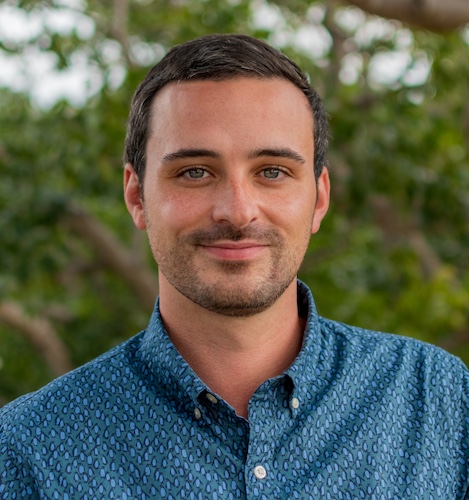Mathematics on Ice
A math degree and a passion for hockey helped Brian Carothers (B.S. ’13, mathematics) score his dream job in sports data analytics.
Brian Carothers (B.S. ’13, mathematics) was just 6 years old when he picked up a hockey stick for the first time. Fascinated by the game and inspired by his hometown team, he knew he’d found his passion.
“When I was six, the Pittsburgh Penguins, my favorite team, went on a deep run to the conference championship and it was just a perfect storm of right place, right time,” Carothers recalled. “I just completely fell in love with playing hockey. I was constantly playing in my driveway, my neighbor’s driveway, the street, and it became an obsession, one of my favorite things growing up.”

Many years later, Carothers still loves hockey. And he found a way to make a career out of it—not by taking shots on the ice, but by making an impact behind the scenes. In 2022, Carothers joined Big League Advantage, a D.C.-area investment company that offers financial support to help talented amateur and minor league athletes achieve their dream of a career in professional sports.
As a data scientist, Carothers leads BLA’s hockey division, developing models, predictive statistics and analytics to measure the value and performance of promising players around the world. It’s difficult, complicated work—and Carothers wouldn’t have it any other way.
“Sports data is incredibly challenging to work with,” Carothers said. “It’s messy, it’s incomplete, there can be small sample sizes, so it requires a unique way of thinking and problem-solving—and I love it.”
A major decision for math
In 2008 when Carothers arrived at the University of Maryland as a freshman, he was still passionate about hockey, but not so certain about his future. His major changed more than once, but when he started taking college-level math and statistics classes he suddenly realized exactly where he belonged. And no one was more surprised than he was.
“If you told me in high school or even my first two years at Maryland that I was going to have a math degree I would have laughed—but I discovered that I really liked it,” Carothers explained. “Math is a way of critical thinking where you’re trying to piece together the information that you know and ways to link that information in ways that are new to you to solve or prove things. It’s like a big puzzle where you’re trying to connect the dots—and that’s what I fell in love with.”
Though Carothers still wasn’t sure what he was going to do with math career-wise, he was confident that with a strong math skill set under his belt, he’d be able to figure that out.
“I finally decided that any door that I wanted to be opened later on down the line, math will be able to open that for me,” Carothers said.
After he graduated, Carothers landed an accounting job with a Maryland construction company. Meanwhile, he was still watching hockey whenever he could and developing a growing interest in the statistical side of the sport. Especially intrigued by programming, Carothers enrolled in a four-month data science boot camp, which inspired him to start experimenting with hockey statistics in his spare time.
“I was starting to build my first models for getting a player rating—one number that encompasses how good I think they are—and this was incredibly basic since I was still really new to data science back then,” Carothers recalled. “It was really fun, but I remember at the time my friends were like, ‘What are you doing? Why are you spending all your free time doing this?’”
In 2017, thanks to his boot camp training, Carothers shifted into a new professional role as a data science manager and consultant, developing systems and products for a variety of business clients. But he was determined to make hockey his career. His first opportunity came a year later with an offer from Analystics Hockey Data Science, a tech startup aimed at providing data analytics to teams in the National Hockey League.
“We were creating a product to help general managers manage everything about their team—the salary cap, their players, all of that,” Carothers explained. “Our twist was that instead of a player rating, like this guy’s a 5.3, we would try to put his value in terms of salary cap dollars. Is the team getting the most for their money?”
For Carothers, it was a perfect opportunity—while it lasted. After COVID hit in 2020, pro hockey essentially shut down and so did the startup.
Taking another shot
Two years later, Big League Advantage gave Carothers a shot. Launched by a former professional baseball player, the company uses predictive algorithms to identify rising stars in sports and invest in their careers, offering an upfront investment to help pay the players’ expenses in exchange for a future percentage of their professional sports earnings. The company invested in baseball, football and basketball athletes. In 2022, when Big League Advantage decided to add hockey, the company offered Carothers a job.
“They decided they wanted to get into hockey and when they started looking for people, they found me,” Carothers said. “I could be a one-man team and get things running. It’s what I’ve been doing for fun all these years and now I’m doing it for real. I spent about a year just getting all of the data together—that’s how long it took before I could even start to build models and do my real job.”
Now, as BLA’s data scientist for all things hockey, Carothers is assembling mountains of data and developing hockey-specific analytics to identify the most promising players in the game, applying the statistics and problem-solving skills he learned in his classes at UMD.
“The heavy math that I do is typically statistics,” he explained. “I use probably 20 or 25 different sources of data for different amateur leagues around the world, from salary cap information to starting lineups,” he explained, “and we also use advanced statistical data. There are other data sources out there where they tell you every pass, every shot, where the players are on the ice, and these things are really valuable.”
For Carothers, it’s hockey heaven. Years ago, he would never have imagined that a math degree could be the first step to a career in sports, but now, everything just fits.
“It’s the coolest thing,” Carothers reflected. “I never had the skills to make it to the NHL as a player, like far from it. But I’ve kind of made my own way, and it happened to be through math.”
He can’t imagine doing anything else.
“This is what I want to do for the rest of my life. It’s the best thing ever,” Carothers said. “I get to think about hockey all day every day, and even on the rough, challenging days, I’m like, ‘Ah, it’s hockey, it’s fine, it’s fun, and it’s incredibly rewarding. I’m so lucky to be able to do this.’”







